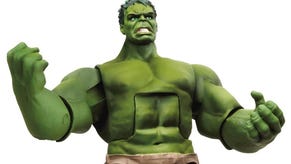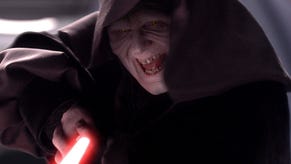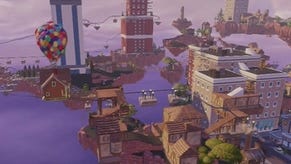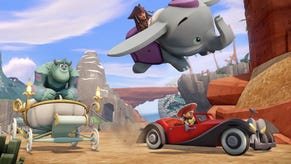Disney Infinity review
Brand on the run.
Disney is in the business of selling magic. Everything it creates is a means to that end. It's certainly something that Disney Infinity is keen to push, opening as it does with a charming - if over-sugared - intro sequence that sees the player plucking a star from the sky and then guiding it through an unfolding world of Disney totems. Look, there's Rapunzel! Here's Wreck-It Ralph! And, of course, Mickey, here to ease you into Infinity's deep world of crossover branding with a little sparkle.
If that sounds rather cynical, it's because - underneath the fairy dust and soaring music - Infinity is a pretty cynical game, a corporate product that cherry-picks elements from the cream of current kid gaming, throws an ungodly amount of money at it and drenches the result in marketing synergy.
It's shameless, but it almost works. Like Activision's hugely successful Skylanders, Disney Infinity is a game where characters and features are unlocked by placing collectable toys on a portal device. The "starter pack" comes with the core game, three toys - Mr Incredible, Sulley and Jack Sparrow - and a three-in-one playset that sits on the portal alongside the toys.
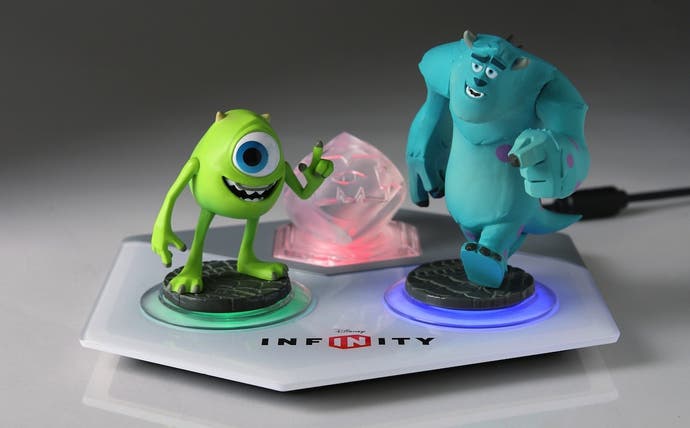
It's these playsets that mark Infinity's biggest difference from Skylanders. While Activision's games have offered add-on toys which add new areas to the game, for Infinity that idea is brought to the forefront. Every set of toys comes with its own playset - essentially a separate campaign based around the relevant movie or TV show.
So Mr Incredible gets a little open-world version of Metro City to romp about in, putting out fires, performing odd jobs for the citizens and trying to stop his nemesis, Syndrome, from destroying the place. As Jack Sparrow, you get to take the helm of your own galleon as you track down the Kraken's Bane, an artefact that will allow you to defeat Davy Jones. And as Sulley, you get to visit Monsters University and engage in a prank war with your rivals at Fear Tech.
Each campaign is of a pretty decent size, lasting about as long as any mid-range kids game, but all feel constrained by having to fit inside the same game engine. Jack Sparrow's Pirates of the Caribbean adventure fares best, simply because the chance to steer, upgrade and customise your own ship gives it a unique feel. The naval combat is a bit sloppy but is rousingly presented and offers a good example of how the Infinity concept could thrive when paired with the right inspiration.
The Incredibles world is also appropriate, offering a bite-sized open-world superhero playground, but repetition quickly sets in as you run, jump and glide around the same city blocks performing simple fetch quests and battling the endlessly respawning Omnidroids and their frustrating knockback attacks. Monsters University is the real let-down of the trio, clearly only included in the starter pack because the movie is still in cinemas, but offering no clear gameplay point of difference.
For a game concept built around characters, there's precious little character on display
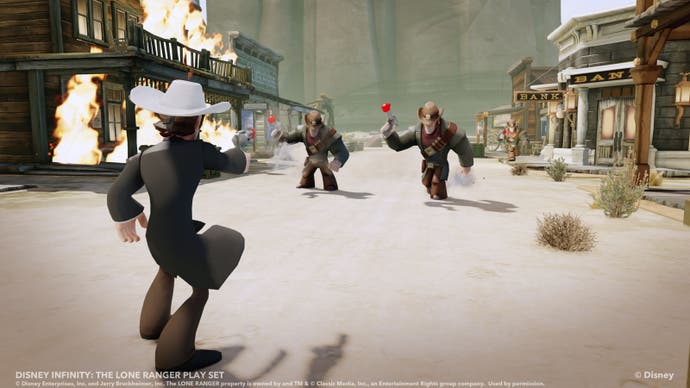
What's missing is the magic. All three games feel rote and oddly sterile, with none of the wit or verve you'd expect from their movie counterparts. Characters regurgitate the same handful of quips and there's little environmental detail to add life to the worlds as you jog along, following the green arrow that directs you to everything you need to do. For a game concept built around characters, there's precious little character on display in these first three examples.
Nor do the playsets allow kids to release that imagination Disney is so fond of invoking. All three supply whimsically charming and pleasingly familiar self-contained micro-worlds to explore, much as Disney's theme parks do - but once in the playsets, characters can't crossover, so you can't have Jack Sparrow cleaning up Metro City or Sulley as the captain of a pirate ship. Segregation comes as standard, and it immediately limits the potential of both the game and the toys.
It also means that the "starter pack" is a non-starter as far as co-op play goes. There's a second slot on the toy portal that allows another player to jump in, but since you only get one character for each world, it's actually impossible to have a two-player game - in the playsets at least - unless you also buy the Sidekick pack which comes with Elastigirl, Barbossa and Mike. This problem feeds through into the worlds themselves, with lots of locked chests and bonus challenges that require a specific character to access. Of course, you can't buy all the characters for a set in one go. Buzz and Jessie from Toy Story are in one pack, Woody in another. It's here that parents will really feel the pinch.
If you want to create a crossover mash-up, you need to venture into the game's second main element, the Toy Box. It's here that you're free to remake the world as you want, grabbing, moving and placing the scenery with a magic wand, and importing new elements, gadgets and characters from your expanding inventory of stuff.
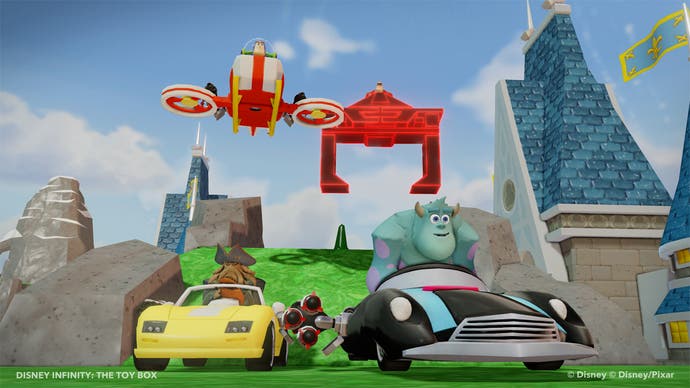
This stuff is accumulated by gathering little vending machine capsules within the playsets, but mostly by taking spins on the Infinity vault. This kid-friendly one-armed bandit spits out one random building element for every spin of the wheel earned through gameplay. It's a mechanic that will be familiar to kids weaned on blind-buying, whether in the form of collectable card games or sticker albums, but it means that the long-term potential of the Toy Box is forever reliant on a roll of the dice.
As a world editor, the Toy Box is rather nicely designed - putting a lot of power in the hands of children and only occasionally getting bogged down in complexities. Contraptions and switches are easy to link together to create moving parts, but making actual games will likely be beyond most young players. The patience required to grind out the parts needed, then to place everything just right, is a big ask. That the best examples that the game itself offers are fairly ropey kart racers and crude platform games, or bland worlds filled with simplistic grind-rail rollercoasters, doesn't inspire much confidence for Infinity's future as a robust creative tool.
Where Infinity really falls down is in how poorly it ties all its disparate pieces together. The game is a tangle of menus and incompatible game modes. Objects bought in the Toy Store inside a playset aren't the same as objects won from the Infinity Vault, meaning kids will be easily confused as to what they've unlocked for use and where. Some tools remain in the playset, others can be brought out but with limited use. A Monsters University toilet roll gun drapes trees in loo roll inside its own playset, for example, but they only bounce off pointlessly when taken into the Toy Box. Anywhere that a little charm or delight could be injected into the experience, Infinity too often fails to deliver.
Structurally, Infinity can be a bewildering maze, as well. For example, ready-made Toy Boxes downloaded from the Toy Box Share menu aren't actually available from within the Toy Box. You have to quit back to the start and access them from the sharing menu where you downloaded them - something that the game never explains. The same is true of the starter playsets - launching a new one means retreating to the opening menu and starting over. Disneyland is famously designed so that the real world is never visible from the inside. That doesn't happen here, where getting from one place to another means breaking the illusion and wading through options before dropping back into the fantasy. While the basic interactions are agreeably simple and intuitive, navigating the package itself is a muddle.
Disneyland is famously designed so that the real world is never visible from the inside. That doesn't happen here, where getting from one place to another means breaking the illusion

Worst of all, in the midst of all these overlapping systems, the toy concept gets almost completely lost. Characters level up, but in doing so gain no additional strength or power. The whole point of Skylanders is that you can build up your characters and swap them for ones best suited to a specific situation - and when they run out of health, they have to be replaced.
In Infinity, characters spring back to life instantly with no penalty, their upgrades are all purchased in-game at specific points and since you can only ever have a handful of characters in any one playset - most offer two or three, The Incredibles can accommodate five - the fact that there's a toy on a portal soon becomes an abstract background detail rather than the driving force of the game design.
There's good stuff in here, but also a lot of clumsy design and irritating obstruction. Too often, the need to sell toys seems to override the design, and the assumption that kids will keep playing to unlock more stuff relies more on the power of the Disney brand than the gameplay on offer. It's a game that invites dozens of nitpicking complaints, as did both Lego and Skylanders when they first appeared, but the game (or games) at Infinity's heart just aren't compelling enough to easily deflect them.
As a platform for future Disney games, Infinity could surprise us yet. It's certainly more promising than the flavourless Disney Universe, and the playset concept means that improvement is only ever one great expansion away. That greatness isn't here yet, however. While Infinity is adequate in basic gameplay terms, and will certainly amuse Disney-fixated youngsters for a while, it falls short of the games whose ideas it borrows.


